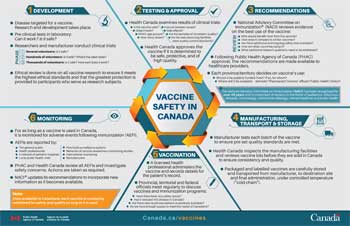Immunization and vaccine awareness poster: Vaccine safety
1. Development
- Disease targeted for a vaccine. Research and development takes place.
- Pre-clinical tests in laboratory: Can it work? Is it safe?
- Researchers and manufacturer conduct clinical trials.
Phase:- Several volunteers: Is it safe?
- Hundreds of volunteers: Is it safe? What's the ideal dose?
- Thousands of volunteers: Is it safe? How well does it work?
- Ethical review is done on all vaccine research to ensure it meets the highest ethical standards and that the greatest protection is provided to participants who serve as research subjects.
2. Testing & approval
- Health Canada examines results of clinical trials:
- Is the vaccine safe?
- Does it work?
- Which age groups?
- How many doses?
- Interval between doses?
- Side effects?
- Are the samples of consistent quality?
- Do the manufacturing facilities meet quality control standards?
- Health Canada approves the vaccine if it is determined to be safe, protective, and of high quality.
3. Recommendations
- National Advisory Committee on ImmunizationFootnote 1 (NACI) reviews evidence on the best use of the vaccine.
Review:- Who would benefit most from the vaccine?
- How does it compare to similar vaccines?
- Are there additional and ongoing safety data available?
- How are other countries using it?
- What additional research questions need to be addressed?
- Following Public Health Agency of Canada (PHAC) approval, the recommendations are made available to healthcare providers.
- Each province/territory decides on vaccine’s use:
- Should it be publicly-funded (free)? If so, for whom?
- Where will it be available – Schools? Pharmacies? Doctors’ offices? Public Health Clinics?
4. Manufacturing, transport & storage
- Manufacturer tests each batch of the vaccine to ensure pre-set quality standards are met.
- Health Canada inspects the manufacturing facilities and reviews vaccine lots before they are sold in Canada to ensure consistency and quality.
- Packaged and labelled vaccines are carefully stored and transported from manufacturer, to destination site and final administration, under controlled temperature (“cold chain”).
5. Vaccination
- A licensed health professional administers the vaccine and records details for the patient’s record.
- Provincial, territorial and federal officials meet regularly to discuss vaccines and immunization programs:
- Have there been any safety issues?
- Has it reduced this disease in Canada?
- Are there new recommendations or products available?
- Do we have enough supply to meet the needs of Canadians?
6. Monitoring
- For as long as a vaccine is used in Canada, it is monitored for adverse events following immunization (AEFI).
- AEFIs are reported by:
- The general public
- Health professionals
- A network of pediatric hospitals
- Local public health units
- Provincial surveillance systems
- Networks of vaccine researchers conducting studies
- International monitoring
- Manufacturers
- PHAC and Health Canada review all AEFIs and investigate safety concerns. Actions are taken as required.
- NACI updates its recommendations to incorporate new information as it becomes available.
Note: Once available to Canadians, each vaccine is constantly monitored for safety and quality as long as it is used.

Download the alternative format
(PDF format, 561k, 1 page)
Organization: Public Health Agency of Canada
Type: Poster
Date published: 2017-04
Related Topics
Page details
- Date modified: